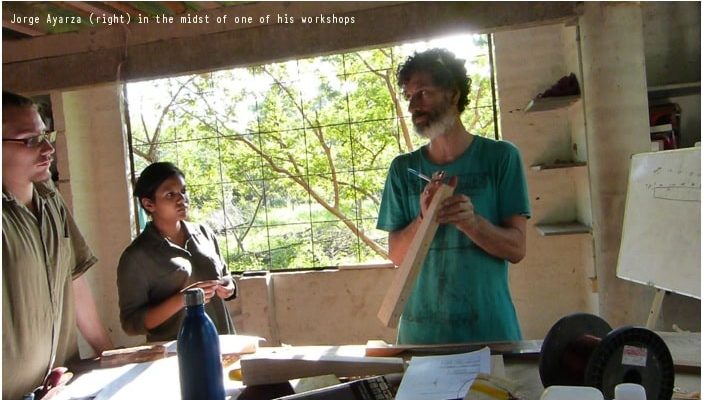His initiative, MinVayu, arms rural youth in India with know-how on small scale green power generation
◊ By Vivek Tejaswi
Harnessing power through green, renewable energy based sources is usually considered exorbitant and tedious, a viewpoint which is not altogether incorrect. On a large or medium scale, the process—technology, investment, installation, maintenance, etc—is challenging. Conversely, existing technologies are capable to meet demands, albeit with certain trade offs and investments. But given the hazards and risks that stem from relying on fossil fuel-based energy sources such as carbon emission and global warming, harvesting energy from renewable sources is the most logical technological solution at present and, thus, investing in such technologies is constructive.
Jorge Ayarza trains rural youth and mechanics to make robust, low cost turbine systems, which can be installed and maintained easily. Starting from a range of 100-watt systems, these go up to 2.5-kilowatt capacity and are capable of functioning in the toughest of locations. The systems can function at minimum wind speed (approx 1.5-2.0 km/hour)—and are affordable—with most of the components being made from local materials
Acknowledging the seriousness of fossil fuel consumption’s long term impact, a number of developed countries have already joined the green movement, minimising their carbon footprint and promoting renewable energy technology. But an emerging economy like India has its own cluster of challenges and barriers.
Meanwhile, at a small scale level, an alternative movement of electrifying unelectrified homes, either through solar or hydro power or wind off grid decentralised systems, has started bearing results, even in the remotest areas.
Jorge Ayarza’s MinVayu
One of the pioneers of this movement is Jorge Ayarza, an Ecuadorian wind energy expert, who designed a customised technological solution for creating wind turbines tailored specifically for the Indian rural landscape. Although India is ranked 5th globally in wind based electricity generation, until Ayarza’s intervention, nothing catered to the local level, despite the fact that wind energy has potential to generate sufficient amount of electricity, even at a small scale.

One of MinVayu’s low cost wind turbines
The few innovations that had already been made in the field of small scale wind power generation were either not accessible to all or could not be scaled up in the desired manner. Ayarza, who has travelled the world in order to better comprehend the mechanics and functionality of different kinds of wind turbines and has also worked with the United Nations Development Programme (UNDP) in China on the largest rural electrification project in the world, created a comprehensive workshop to train youths and mechanics from rural areas to give them access to affordable, local small scale wind turbine technology.
Following six arduous years of experimentation, in 2010 he founded his own venture, MinVayu (meaning ‘electricity wind’) under the umbrella of the Auroville International Township. He developed a training module wherein individuals would be trained in the mechanics and physics of making robust, low cost turbine systems, which can be installed and maintained easily. Starting from a range of 100-watt systems, these go up to 2.5-kilowatt capacity (operational capacity) and are capable of functioning even in the toughest of locations (one was installed and tested in the high altitude of the Himalayas, in Nepal; one survived the heavy wind and thunderstorm of 2011-12 in Puducherry).
The systems are effective—they can function at minimum wind speed (approx 1.5-2.0 km/hour)—and affordable— most of the components are made from local and easily available materials. For instance, for making the blades of the turbine, old recycled wood is used, which is further aerodynamically carved by hand. Whereas other basic utility parts, such as metal plates (made from vehicle brake discs), copper wire, epoxy, resin, magnets, electronic components, etc, are mostly either recycled materials or can be easily bought from any hardware store. The effective training workshop is designed especially so any layman can craft wind turbines and the handmade design ensures rugged and robust build.
In the early stages, the training was conducted twice a year. Usually, the training and workshop are organised in Auroville, Puducherry, but in special cases, onsite training is also facilitated. In the past six years, Ayarza has trained almost 250 Indian and foreign youths. A few NGOs in Auroville (ProtoVillage, Bharatiya Agro Industries Foundation) and some other organisations have adopted and installed these systems. And more recently, after his design was tested at the Chennai facility of the National Institute of Wind Energy (NIWE), Ayarza also signed a memorandum to provide training on such turbine systems to the students and researchers of the institute.
However, a number of challenges still confront MinVayu and prevent it from realising its full potential—namely, lack of funds and basic infrastructure and the hesitation of people to adopt new ideas and technology.
Jorge Ayarza and MinVayu’s contributions to the wind energy generation field in rural India exemplify renewable energy technology can become so local that any individual can afford electricity generation and at minute scale, and thus, play a vital role in the green energy production movement.

The author is an Electronics and Communication Engineer and a Development Practitioner engaged in robotics and rural development projects since 2011



Hi. Can you share contacts of Jorge.